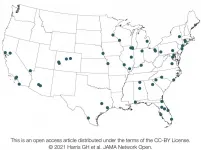(Press-News.org) PITTSBURGH, March 19, 2021 - A University of Pittsburgh School of Medicine-led survey of dozens of surge capacity managers at hospitals nationwide captures the U.S. health care system's pandemic preparedness status in the months before the first COVID-19 cases were identified in China.
Published today in the journal JAMA Network Open, the investigation details the strain experienced by U.S. hospitals during the 2017-18 influenza season, which was marked by severe illness and the highest infectious disease-related hospitalization rates in at least a decade. At the time, pandemic planning within hospitals was not reported as being a high priority.
"The timing for our survey couldn't have been better--ultimately it serves as a pre-COVID-19 time capsule of our preparedness to accommodate surges in patients needing hospitalization for acute illness," said senior author David Wallace, M.D., M.P.H., associate professor in Pitt's departments of Critical Care Medicine and Emergency Medicine. "It was surprising to hear very detailed stories of the strain hospitals were under during the 2017-18 flu season, and yet have no pandemic planning come out of it."
The 2017-18 flu season was associated with more than 27.7 million medical visits, nearly a million hospitalizations and almost 80,000 deaths, according to the U.S. Centers for Disease Control and Prevention. That is more than double the deaths in a typical flu season and the highest hospitalization rate since seasonal influenza surveillance was instituted in 2005.
Wallace and his team--which included specialists in health policy, medical anthropology and infectious diseases--interviewed surge capacity managers at a random sampling of 53 hospitals across the U.S. starting in April 2018, at the tail end of the flu season. Using a structured survey, they recorded detailed interviews about everything from ICU bed capacity and staffing ratios to the perceived effect of strain on quality of patient care and staff well-being.
All of those surveyed reported experiencing hospital strain during the 2017-18 flu season. Strain was generally described as the result of high patient occupancy causing demand to outstrip the supply of resources--in fact or in perception.
The "4 S's"--staff, stuff, space and systems--were reported as the widespread challenges that surge capacity managers consistently faced in continuing health care operations during the flu season. Staff was a particular concern, due to fatigue or staff being out sick with flu or caring for ill family.
"This demonstrates that the perceptions of strain on staffing, patient care and capacity that we have seen during the COVID-19 pandemic were already present with prior epidemics," said lead author Gavin Harris, M.D., an assistant professor in the Emory University School of Medicine, who did this research while at Pitt. "Less than two years before COVID-19 took off in the U.S., we were experiencing a preview of the strain that a fast-spreading, severe respiratory infection places on our health system."
In fall 2013--four years before this challenging flu season--the U.S. Department of Health and Human Services Office of the Assistant Secretary for Preparedness and Response produced the Interim Healthcare Coalition Checklist for Pandemic Planning report, which identified eight categories hospitals should address when planning for crises, specifically surges in acute care needs. None of the survey participants commented on all eight categories, nor did any specifically report using the checklist.
"Hospitals have a tendency to deal with what's right in front of them, the present," Wallace said. "In doing that, we must also learn when certain levers--like a pandemic preparedness checklist--must be pulled. That is done through reflecting after a crisis subsides and looking for opportunities to improve before the next crisis hits. If the past year has taught us anything, it's that infectious diseases aren't going away, and we'll always get a chance to put lessons learned to work."
INFORMATION:
Additional authors on this research are Kimberly Rak, Ph.D., M.P.H., Jeremy Kahn, M.D., M.Sc., Derek Angus, M.D., M.P.H., Olivia Mancing and Julia Driessen, Ph.D., all of Pitt.
This research was supported by National Institutes of Health grants R03HL16020, K08HL122478 and K24HL133444.
To read this release online or share it, visit https://www.upmc.com/media/news/031921-wallace-hospital-capacity-jama [when embargo lifts].
About the University of Pittsburgh School of Medicine
As one of the nation's leading academic centers for biomedical research, the University of Pittsburgh School of Medicine integrates advanced technology with basic science across a broad range of disciplines in a continuous quest to harness the power of new knowledge and improve the human condition. Driven mainly by the School of Medicine and its affiliates, Pitt has ranked among the top 10 recipients of funding from the National Institutes of Health since 1998. In rankings recently released by the National Science Foundation, Pitt ranked fifth among all American universities in total federal science and engineering research and development support.
Likewise, the School of Medicine is equally committed to advancing the quality and strength of its medical and graduate education programs, for which it is recognized as an innovative leader, and to training highly skilled, compassionate clinicians and creative scientists well-equipped to engage in world-class research. The School of Medicine is the academic partner of UPMC, which has collaborated with the University to raise the standard of medical excellence in Pittsburgh and to position health care as a driving force behind the region's economy. For more information about the School of Medicine, see http://www.medschool.pitt.edu.
http://www.upmc.com/media
Contact: Allison Hydzik
Office: 412-647-9975
Mobile: 412-559-2431
E-mail: HydzikAM@upmc.edu
Contact: Wendy Zellner
Office: 412-586-9777
Mobile: 412-973-7266
E-mail: ZellnerWL@upmc.edu
A new research study at the University of Chicago Medicine has found that when it comes to COVID-19, having vitamin D levels above those traditionally considered sufficient may lower the risk of infection, especially for Black people.
The study, published March 19 in JAMA Open Network, retrospectively examined the relationship between vitamin D levels and likelihood of testing positive for COVID-19. While levels of 30 ng/ml or more are usually considered "sufficient," the authors found that Black individuals who had levels of 30 to 40 ng/ml had a 2.64 times higher risk of testing ...
What The Study Did: This analysis examined how patients with multiple sclerosis who have COVID-19 fare and what patient and disease characteristics are associated with worse outcomes.
Authors: Amber Salter, Ph.D., of Washington University in St Louis, is the corresponding author.
To access the embargoed study: Visit our For The Media website at this link https://media.jamanetwork.com/
(doi:10.1001/jamaneurol.2021.0688)
Editor's Note: The article includes conflict of interest and funding/support disclosures. Please see the article for additional information, including other authors, author contributions and affiliations, conflict of interest and financial disclosures, ...
What The Study Did: Researchers examined if differences in vitamin D levels greater than levels traditionally considered sufficient (30 ng/mL) are associated with having test results positive for COVID-19 in White and in Black individuals.
Authors: David O. Meltzer, M.D., Ph.D., of the University of Chicago, is the corresponding author.
To access the embargoed study: Visit our For The Media website at this link https://media.jamanetwork.com/
(doi:10.1001/jamanetworkopen.2021.4117)
Editor's Note: The article includes funding/support disclosures. Please see the article ...
A multinational research team led by Dr. Adnan Sljoka (RIKEN), Prof. R. Scott Prosser (Univ. of Toronto) with collaborations with Dr. Duy Phuoc Tran and Prof. Akio Kitao (Tokyo Tech) and Prof. Roger K. Sunahara (Univ. of California San Diego) has carried out experimental and computational studies, revealing key steps associated with the activation of the human adenosine A2A receptor (A2AR). A2AR is a member of superfamily of receptors called G protein-coupled receptors (GPCRs) (major drug targets) which engage the G protein and initiates cell signaling. The research team discovered that A2AR is represented by at least two inactive conformations and three active conformations whose populations are dependent on ligands and activation ...
A team of researchers has found disrupting the interaction between cancer cells and certain immune cells is more effective at killing cancer cells than current immunotherapy treatments.
The findings, which include studies in cell lines and animal models, appeared in JCI Insight and focus on END ...
MOSCOW, RUSSIA -
Moscow Center for Diagnostics & Telemedicine and RADLogics shared the results of a large-scale study (Moscow Experiment on the Computer Vision for the Analysis of Medical Images - mosmed.ai, NCT04489992) conducted by the Research and Practical Clinical Center for Diagnostics and Telemedicine Technologies of the Moscow Health Care Department. The clinical research found that the introduction of RADLogics' AI-Powered solution into radiology workflow to analyze Chest-CT scans during the COVID-19 pandemic reduced report turnaround ...
TROY, N.Y. -- A novel form of polymerized estrogen developed at Rensselaer Polytechnic Institute can provide neuroprotection when implanted at the site of a spinal cord injury -- preventing further damage. This promising result, found in a preclinical model, was recently published in ACS Chemical Neuroscience, and it lays the groundwork for further advancement of this new biomaterial.
"What we saw that gives us hope is more neuroprotection, meaning we saw more spared neurons and more spared axons in the tissue," said Ryan Gilbert, a professor of biomedical engineering at Rensselaer, and co-author on this paper. "We believe that the estrogen released from our biomaterial design is providing a neuroprotective response."
After a spinal cord injury, the body's inflammatory ...
The results showed that several psychological well-being measures gradually increased within participants from the beginning to the end of the course. That was especially true for life satisfaction, perceived well-being, self-awareness and emotional self-regulation. The participants in the study also reported a significant decrease in anxiety, perceived stress, negative thoughts, rumination and anger tendencies. The researchers observed, simultaneously, improvements in the positive aspects and a reduction of negative emotions, both in the short term and longitudinally ...
UNIVERSITY PARK, Pa. -- Stress is a universal human experience that almost everyone deals with from time to time. But a new study found that not only do some people report feeling no stress at all, but that there may be downsides to not experiencing stress.
The researchers found that people who reported experiencing no stressors were more likely to experience better daily well-being and fewer chronic health conditions. However, they were also more likely to have lower cognitive function, as well.
David M. Almeida, professor of human development and family studies at Penn State, said the study suggests that small, daily stressors could potentially benefit the brain, despite being an inconvenience.
"It's possible that experiencing stressors creates opportunities for you ...
Three University of Colorado Cancer Center researchers are part of a team that recently published a paper offering new insight into how the immune system relates to cancer. Quentin Vicens, PhD, Jeffrey Kieft, PhD, and Beat Vögeli, PhD, are authors on the paper, which looks at how an enzyme called ADAR1 operates in pathways associated with cancer.
"In a cell, ADAR1 edits native RNA -- or self-RNA -- so that the cell recognizes it as its own. It's a key protection against autoimmune disorders," Kieft says. "But if a virus infects, viral RNA isn't edited by ADAR1, so the cell can recognize that and react. The cell knows it has foreign RNA, and it activates immune responses to fight off that infection."
For their paper published last month in the ...


